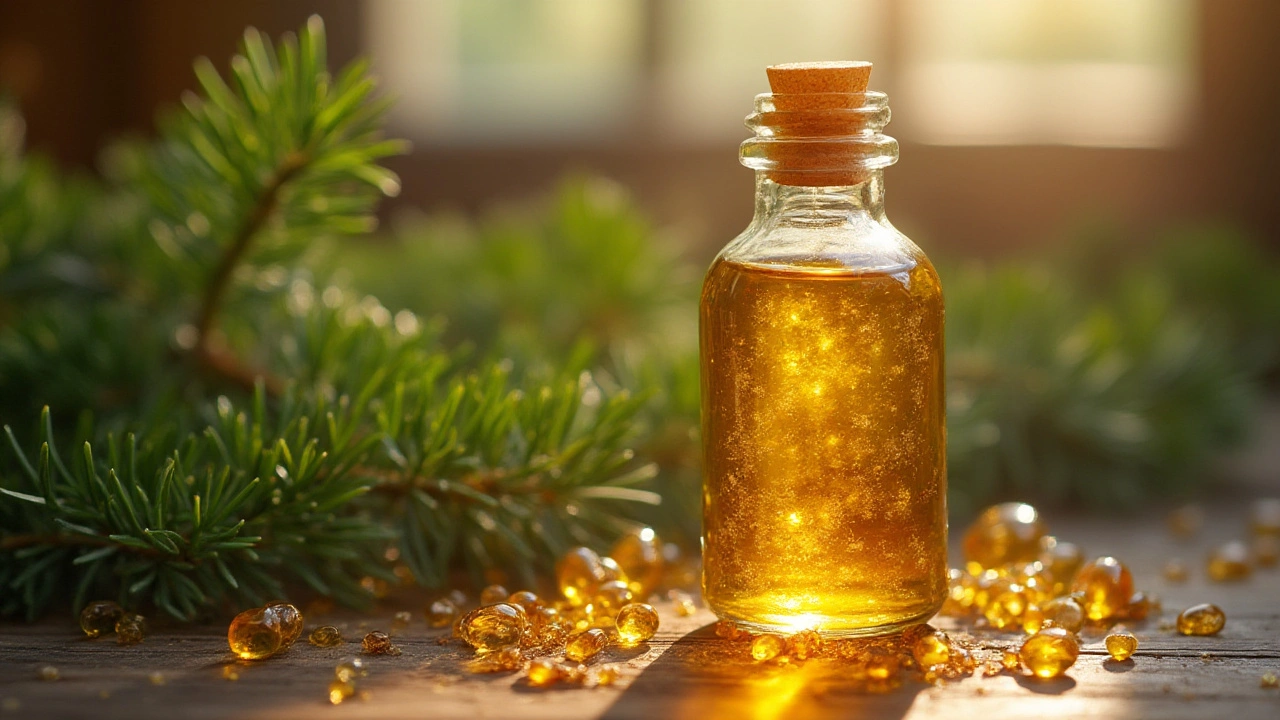Wild forests in Canada have given birth to a sticky, fragrant resin that might just be the wellness world’s most underrated hero. Forget what's sitting on typical vitamin shelves—Canada Balsam isn’t a household name, but it’s centuries-old, packed with pure plant power, and used for everything from stubborn coughs to tough skin infections. This isn’t just another herbal fad: recent curiosity from both science and traditional healers has pointed a spotlight on this pine-scented elixir. There’s a feast of benefits hiding right under our noses—or underfoot, to be more accurate. What exactly is Canada Balsam, and can this sticky tree sap actually make a difference in daily health? Let’s dig deep.
What Is Canada Balsam? The Resin With a Reputation
Everyone’s heard of maple syrup, but walk through a Canadian fir forest in the summer and it’s another sticky substance that sneaks under your fingers. Canada Balsam comes from the balsam fir tree (Abies balsamea), a soft, needle-leaved evergreen that throws off waves of fresh, citrusy scent. Native peoples in North America used it long before anyone thought to bottle supplement pills. Imagine tapping trees for a golden, semi-liquid resin that’s brimming with unique terpenes and natural acids—this isn’t an artificial extract, but a raw product nurtured by tree sap itself.
This resin is different from the sticky pines you hated touching as a kid—Canada Balsam doesn’t harden into a mess; it stays pleasantly soft, almost like honey, and has an appealing aroma that hints at the deep woods. Although it’s famous in microscopy (used to mount samples on slides) and sometimes pops up in fancy art preservation, it’s gaining real buzz for its medicinal potential. Researchers have found that its chemical makeup includes compounds like alpha-pinene, beta-pinene, limonene, and bornyl acetate. Taken together, these create its signature scent—and pack a punch for health.
There’s a huge story behind how First Nations people used it. Balsam fir resin was their go-to for healing wounds, easing colds, relieving congestion, and even as a chewing gum for mouth sores. While it’s usually collected straight from the bark using specialized spatulas today, old-school gatherers used their hands, relying on touch and the subtle changes in tree sap throughout the seasons. It’s not as mainstream as elderberry or echinacea, but its background is just as rich.
Science-Backed Health Benefits of Canada Balsam
If you love finding plant-based solutions with real science behind them, Canada Balsam delivers. Modern studies—yep, real peer-reviewed work—are shining a light on what the old folk wisdom already guessed: this resin isn’t just sticky, it’s potent. One study published in 2017 in “The Journal of Ethnopharmacology” found that compounds in Canada Balsam inhibit the growth of bacteria like Staphylococcus aureus and Streptococcus pneumoniae, making it a serious candidate for natural wound care and fighting respiratory bugs.
We’re talking more than just basic antibacterial action. The resin’s anti-inflammatory properties can help soothe sore throats and skin flare-ups. Another peer-reviewed study (published in “Fitoterapia” in 2019) credited the resin’s cocktail of terpenes as responsible for lowering inflammation when applied topically or taken in gentle supplement form.
But it doesn’t stop at fighting germs or swelling. Canada Balsam packs a surprising antioxidant punch, meaning it helps combat those pesky free radicals linked with chronic diseases and aging. A study by Canadian biochemists in 2021 found that its essential oil reduces oxidative stress in cell models. The upshot? A shot of this in your wellness routine could help the body ride out environmental toxins and lower daily wear-and-tear.
Need numbers? Check this out:
| Active Compound | Noted Benefit | Main Source |
|---|---|---|
| Alpha-pinene | Anti-inflammatory, bronchodilator | Canada Balsam resin |
| Limonene | Antioxidant, mood support | Fir & citrus oils |
| Bornyl acetate | Sedative, calming effects | Balsam fir oils |
| Beta-pinene | Antibacterial, analgesic | Fir resin |
Folks who use it regularly say they feel better breathing, they’re less bothered by winter coughs and congestion, and their skin recovers quicker from cuts or burns. That’s not placebo—science keeps echoing the old wisdom with real data and chemical breakdowns.

Everyday Healing: How People Use Canada Balsam
So, how can you actually use Canada Balsam? This is where it gets surprisingly versatile. Some turn the resin into supplements, tinctures, or drops, while others rely on the essential oil version. If you’ve got a persistent cough or sinus troubles, a few drops of diluted Canada Balsam oil in a steamy bowl (held under your nose) can clear the head better than some over-the-counter vapo pots. It works by relaxing airways and helping the body clear out mucus, making it a favorite among folks dealing with harsh winters or stubborn allergies.
Ever tried homemade wound salve? If not, Canada Balsam resin blends well with beeswax to make a DIY antibiotic ointment. It cuts down on red, swollen skin, helps stave off infection, and encourages new skin to form over minor scrapes and burns. Perhaps more importantly, the resin doesn’t sting the way alcohol-based cleansers do. Just don’t use it on deep wounds or without a patch test for allergies.
On the dietary front, some herbalists swear by a small oral supplement (usually resin that’s been purified and diluted) as a way to boost general immune health and relieve digestive discomfort. Ancient users even chewed the solid resin as gum for fresh breath and to clean their teeth. In a world packed with processed mints and sugary gums, it’s kind of wild to think a bit of tree sap could do the trick. Tip: Look for third-party tested supplements, since purity makes all the difference—a reputable brand will show lab certificates or mention sourcing from wild, pesticide-free forests.
Common ways to use Canada Balsam:
- Steam inhalation for coughs and sinus relief
- Homemade balm or ointment for small wounds
- Supplement form (resin capsules or tincture)
- Chewed as a natural gum substitute
Some practitioners recommend mixing a drop of essential oil into coconut oil as a chest rub—just don’t apply directly to broken skin without proper dilution. And if you’re after a mood boost, a whiff of the oil on a tissue can work like forest therapy, triggering relaxation through the limbic system.
Safety, Sourcing, and Choosing the Right Product
Let’s be real: not all supplements are created equal. And since Canada Balsam isn’t as mass-produced as, say, fish oil or vitamin C, you have to pick carefully. Always look for wild-harvested or organic resin, ideally from Canadian companies with transparent supply chains. If a supplement doesn’t show a batch number or a harvesting location, skip it. This isn’t paranoia—fir trees can absorb soil contaminants if grown in polluted regions. Ask questions before you buy.
As for safety, Canada Balsam is usually well-tolerated in moderate amounts. That said, concentrated essential oil can irritate sensitive skin or noses if not diluted. Always do a patch test and start with a tiny amount. People with allergies to pine or fir sap should probably steer clear, and anyone pregnant or breastfeeding should ask their doctor first—just common sense. Internally, supplements should be third-party tested for purity. Never use old resin collected from the ground, as it can mold or lose potency over time.
Here’s a quick cheat sheet to picking a product:
- Check for “wild-harvested” or certified organic on the label.
- Look for lab test results or certificates of analysis from the brand.
- Start with a lower dose—some folks are more sensitive to natural resins.
- Use only as directed. Don’t toss it into random DIY skincare without research.
- Keep it away from kids, pets, and people with known tree allergies.
Canada Balsam isn’t super cheap, mostly because ethical harvesting takes time and protects the health of the forest. But for many, a little lasts a long time and brings bigger benefits than other supplement fads they’ve tried.

Adding Canada Balsam to Your Routine: Creative Ideas & Tips
If you want nature’s best secret in your health stash, there are so many ways to sneak Canada Balsam into your life. For stress relief, try diffusing a few drops of the oil during evening routines. That foresty scent isn’t just pleasant—it’s proven in research from Japan to lower heart rates and decrease stress hormones. Think of it as a way to bring a slice of clean Canadian woods right into your apartment or office.
If you cook, you can add a tiny, food-grade drop to herbal teas or honey blends (just double-check it’s approved for internal use). Some people use it to make a post-workout bath soak—drop some infused oil into Epsom salts for tired muscles. And don’t forget how it shines as a cold remedy: combine with eucalyptus in a steam bowl for a powerhouse combo.
Make your own balsam balm at home with this simple recipe:
- 2 tablespoons Canada Balsam resin
- 4 tablespoons coconut oil
- 1 tablespoon beeswax
Melt the coconut oil and beeswax, then stir in the resin until smooth. Cool in a jar and use on minor skin irritations.
If you love rituals, set aside a quiet time a week to enjoy balsam’s benefits—maybe as part of a slow, meditative skincare routine or just as a pick-me-up during a rainy day. You’ll find it helps reset both body and mind, especially if stress or seasonal bugs have you feeling run down. Nature has always been the best chemist—sometimes you just need the right guide through the forest to find its hidden gems.

Patrick Smyth
July 28, 2025 AT 04:44This is the most beautiful thing I’ve ever read. I felt tears in my eyes thinking about those ancient forests and the resin just… weeping from the trees like nature’s own medicine. I’ve been sick for months and I swear this is the answer. I’m ordering it today.
Michelle Smyth
July 28, 2025 AT 21:39While the romanticization of indigenous practices is aesthetically pleasing, the epistemological foundation of this resin’s efficacy remains ungrounded in reproducible clinical trials. The terpene profile is interesting, yes-but until double-blind RCTs are published, this reads as neo-colonial phyto-mythology dressed as wellness.
ANN JACOBS
July 29, 2025 AT 12:30I’ve spent the last six months researching natural remedies after my autoimmune flare-up, and Canada Balsam has been a quiet revelation. The anti-inflammatory and antioxidant properties aren’t just theoretical-they’ve helped me reduce my reliance on NSAIDs. I use the tincture under my tongue every morning and a balm on my eczema at night. It’s not a miracle, but it’s consistent. And the scent? Like walking through a pine forest after rain. Pure peace.
Nnaemeka Kingsley
July 29, 2025 AT 21:38bro this sounds legit. i tried it last winter when i had a cough that wouldnt go away. one drop in hot water with honey and i could breathe again. no more night coughing. my grandma used to rub it on my chest when i was a kid. she said it was from the trees that talk to the wind. i didnt believe her… until now.
Sean McCarthy
July 30, 2025 AT 20:22Let’s be clear: this isn’t medicine. It’s tree juice. You’re going to spend $40 on a dropper full of sap that’s been sitting in a jar since 2018? And you’re calling it science? The studies cited are in vitro. In vitro means in a petri dish, not in a human body. Also, ‘ancient wisdom’ doesn’t override the fact that people used leeches and bloodletting too.
Jaswinder Singh
July 31, 2025 AT 14:32you people are overthinking this. if your grandpa used it and it worked, why are you arguing over terpenes? i used it on a burn from my stove last year. no infection, no blistering. i didn’t need a PhD to know it helped. stop acting like nature needs your approval before it works.
Bee Floyd
August 1, 2025 AT 19:13I’ve been using this for two winters now. I keep a small tin of the balm on my nightstand. When the air gets dry and my throat tightens, I rub a tiny bit on my collarbone and breathe deep. It’s not magic, but it’s grounding. Like a quiet hug from the forest. I don’t need to prove it to anyone. I just know it helps me show up better for my days.
Jeremy Butler
August 2, 2025 AT 23:52The ontological primacy of the balsam fir resin as a biomolecular interface between anthropogenic wellness and phytogenic intelligence remains an underexplored frontier in ethnobotanical epistemology. Its chemosignaling properties suggest a non-linear paradigm of healing that transcends the reductionist model of pharmaceutical intervention.
Courtney Co
August 3, 2025 AT 06:51I tried this and it made my skin break out. I’m not saying it doesn’t work-I’m saying it’s not for everyone. But you people act like it’s the cure for cancer. I’m just saying… maybe don’t put tree sap on your face without testing it? Also, I’m ordering it anyway because I’m desperate.
Shashank Vira
August 4, 2025 AT 07:39How quaint. A colonial artifact repackaged as ‘wellness’ for the Instagrammable proletariat. The real tragedy? The balsam fir forests are being stripped by ‘ethical harvesters’ who charge $75 for a 10ml vial while indigenous communities are denied access to their ancestral medicine. This isn’t healing-it’s spiritual capitalism.
Eric Vlach
August 6, 2025 AT 02:11Been using this for years. Just a dab on the chest when the cold hits. Works better than anything in the pharmacy aisle. Don’t overcomplicate it. If it smells like pine and helps you breathe, you’re good. No need for certificates. Just trust your nose and your body.
Lydia Zhang
August 7, 2025 AT 16:07Interesting
Kay Lam
August 8, 2025 AT 19:10I’ve been making my own balm for the past three winters and I can’t believe how much better my skin feels. I mix it with shea butter and a drop of lavender. My hands don’t crack anymore. I even gave some to my neighbor who’s got psoriasis and she said it’s the only thing that’s ever calmed the redness. It’s not fancy, it’s not expensive, it’s just… real. And that’s rare these days.
Matt Dean
August 9, 2025 AT 06:00Anyone who believes in tree sap as medicine shouldn’t be allowed to vote. This isn’t holistic health-it’s gullibility with a pine scent. You’re not healing. You’re just being manipulated by influencers selling bottled forest air.
Walker Alvey
August 9, 2025 AT 16:00Oh look another magical forest juice that’s going to fix your anxiety, your cough, your bad karma and your ex’s text messages. Next they’ll sell you pinecone tea for manifestation. The real epidemic isn’t illness-it’s the desperate need to believe in something that sounds mystical but costs $49.99
Adrian Barnes
August 11, 2025 AT 01:47The methodology of the cited studies is flawed. Small sample sizes, lack of control groups, and no standardization of resin composition. The purported benefits are anecdotal at best and dangerously misleading at worst. This is not evidence-based medicine. It is pseudoscientific marketing disguised as ancestral wisdom.
Declan Flynn Fitness
August 12, 2025 AT 11:28Used this on a blister after a long hike. No infection, no pain. Just calm healing. I keep a little jar in my first aid kit now. Also, the scent is like walking through a quiet forest at dawn. Pure vibes. 🌲💙
Linda Migdal
August 12, 2025 AT 18:55Canada? We have better stuff here. This is just a tourist gimmick. Real medicine comes from American labs, not some sticky tree in the north. Why are we even talking about this?
Tommy Walton
August 14, 2025 AT 02:03Tree sap? Bro, I’m not putting pine juice on my skin. I’ve got a $200 serum from Seoul that’s got 17 peptides and a hologram. This is like using mud instead of a Tesla.